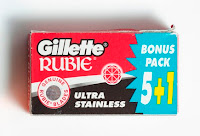The Creative Guild’s very frst radio ad of the year drew
inspiration from the popular slice-of-life format, but further injected
situations with a delightful brand of anticlimactic Pinoy humor.
As Bill Ibañez, then associate creative director of
McCann-Erickson, now creative director at Great Wall Avertising and father of
the RUBIE “Harana” 30-seconder ad, likes to say “Humor is my specialty. And
Filipinos love it when a situation has a humorous twist.”
 |
| Source: flickr, Arne Kuilman |
The client was Gillette Philippines, a 15-odd-year
associate of McCann-Erickson, and the product was
RUBIE Blade. When Ibañez took over the account, a popular campaign
and a TV campaign starring the late comedian Vic Pacia were already airing. Client
wanted to employ radio to encourage the men in downscale rural market to please
shave.
“A lot of men out there were still using primitive implements
to get rid of their bristles.” Ibañez explains. Such grooming innovations included
two coins used as a makeshift tweezers or even splinters of wood. That is, if
the gentleman ever bothered with his bristles at all.
Ibañez decided to utilize the popular jingle , which made
a simple but very attractive promise, If you shaved with RUBIE, you would look good. “Ahit
RUBIE, Ahit Pogi”—the eqution of the brand name with a Filipino slang for “handsome”
was only of the cmpaign’s winning elements. Ibañez went a step further by
pushing the satisfied user over the deep end; the hero becomes so handsome
that, by the end of the commercial, he has a new problem altogether, “He
becomes too good-looking for his own good.”
In “Harana”,
only one of the several presentations of the delicious RUBIE dilemma, a fellow with the unsavory name of Tiagong Tuchang pays court to Kathleen,
whose mother immediately puts the light out on the suitor because of his
unshaven state. Calling him “tuchang” ,
a terribly coarse kind of bristle, is bad enough. “Yung hindi nag-aahit! Yung mukhang piña!”, the mother exclaims,
and the listener goes to town figuring out how unbelievably fuzzy Tiago really
looks.
RUBIE is
presented as a resolution, and the playing of the jingle signifies that the
hero has taken matters an razor into his own hands. He returns to Kathleen, who
is so taken by the serenade (and the newly-trimmed serenade) that she asks for an
encore. The crow of rooster and a young
man’s moan, “Josko, umaga na!” is the
final twist and the hilarious revelation of just how many encores the now
desirable Tiago was obliged to give.
Listeners began to await the next RUBIE Blade radio commercial like radio drama or comic
installments, “The listener knew it was an exaggeration, because there was no
attempt to present the situation as logical,” Ibañez recalls. Thus, they
laughed heartily at the final turn of events, which, in subsequent versions,
always had the hero ending up with more than he bargained for—as in a shotgun
wedding, pehaps, or having more than one barrio lass demanding his attention.
From the distinguishing sound effects that set the ads
apart from auditory clutter—a series of urgent knocks, or, in the case of “Harana”, the strum of a guitar---to the
familiar characters and easily recognizable values, the RUBIE ads hit the Pinoy at his very heart. “They were indigenous
and romantic,” Ibañez says. “The strength of the campaign was in fact that
people recognized themselves in it.”
Enough to keep RUBIE
Blade in the market for years to come.
CREDITS:
ADVERTISER:
Gillette Philippines
PRODUCT: Rubie
Blades
AGENCY:
McCann-Erickson
ASSOCITE CREATIVE
DIRECTOR: Bill Ibañez
PRODUCER: Baby
Enriquez
SOURCES:
Article written by the late Butch Uy, forPerfect 10: A Decade of Creativity in Philippine
Advertising, written by Butch Uy.Published by the Executive Committee of the
Creative Guild of the Philippines. 1995, p. 66-67














